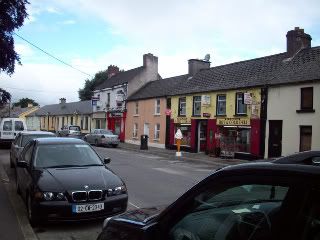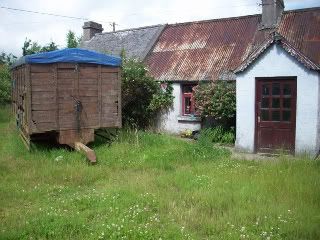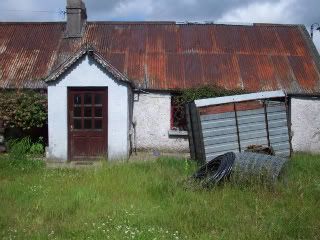We’re about an hour’s train ride out of Dublin, and it’s obvious that we’re not in the city anymore. Most New Jersey towns are busier than this. I don’t know whether that says something about Ireland or New Jersey.


We went to the Carlow library, which, unlike the National Library, put their parish records on a computer printout. It was there that one of our mysteries was solved – how
Francis wasn’t in the book, which means he was born before the record keeping started in 1813. The grave inferred 1811, which fits. He married
Looking for similar parents in the book we found several siblings for Elizabeth – Timothy, Mary, Ellen, Catherine, and John. Siblings of Francis included Denis, Mary, Rose, and Maurice. The death and marriage records aren’t as detailed, so we found only one of these people later on, Maurice’s death in 1908. So for all we know, most of these people died as children.
Speaking of, the book revealed a great uncle my dad didn’t know he had – James, born in 1869. Obviously he had died as a child if we’d never heard of him, but to see that in there was a surprise. (When we returned to
This is where pure dumb luck comes into play.
My dad dragged me all over town, trying to find this one pub he’d eaten at three years ago. I was growing increasingly frustrated with him, since I wanted to go to another place in town to do research and he hadn’t wanted to. Dad couldn’t find the pub, so we settled into lunch at a hotel.
Where we’d wanted to go next was the cemetery that we now knew contained our ancestors. I’d written down the phone numbers of several local cab companies, but we exited the hotel to find two random cabs waiting outside. We climbed into one and showed the driver the directions to the church we’d found online.
“That’d take you 9 km out of the way!” He exclaimed. He drove up to the other cab. “Hey, Pat, can you believe these directions? They want you to take
Turns out, the cab driver, Noel’s, son went to school at its church. He even lived in the town from where those 1940s letters came from. He had us at the cemetery within ten minutes, and told us to call his cell when we were ready to leave.
In the cemetery, Dad found the grave from the website. Finally seeing it in person solved the mystery of Thomas’s missing child. It did not say that he died in 1930 aged 31; he died in 1930 aged 3 ½. But more importantly, I found a grave with the family name that wasn’t on the website. In it were Patrick, Frank, and Luke; the three sons of Thomas mentioned in the letters. Also in that grave was a baby Padraic; this made another mystery baby, as the other grave had a baby John in it. Dad assumed they were the sons of one or two of Thomas’s sons. I mused over it. “There are three brothers here…where are their wives buried?”
Dad and I argued over where to go next. I wanted to go to the church where the actual book of parish records was kept (we’d gotten the priest’s phone number in Carlow), but Dad wanted to go to Rutland and try and track down where the farm was, even though all he had was a map from 1852. We were still debating this when the cab pulled up, but not with Noel; It was Pat, his partner. He asked about what we were looking for, and Dad happened to let the surname of the relatives slip.
“Hey, I know a Tom in
Um…what?
Sure, it was possible that he was named after who would have been his grandfather, but…was he really driving us to a stranger’s house right now?
Yes, he was, and soon we were pulling up in front of a small farmhouse. A redheaded woman came to the door when Pat knocked. Awkwardly, we named a bunch of names for her and asked if it was her family.
She said yes.
Let’s put that in perspective: My dad and I expected to find absolutely nothing about our family history when we came to Ireland and we’d managed to track down living relatives.
The woman at the door was Tom’s wife Eunice, and once realizing we were family instantly invited us in and made tea. Tom was at work. Once of her three kids managed to poke her head in the kitchen, the only blood relative I saw that day – my third cousin Ciara, the oldest at nine years old. Tom’s mother Nancy also lived with them. She was the wife of Luke, and the two babies buried in the cemetery were her children. (Like that wasn’t awkward when we found out that one.) Pat and Frank never married, we found out. Pat had died of a heart attack, and Frank in a boiler explosion accident. (Eep.)
We told them about their cousins over in
Eunice walked us through their apple orchard (!!!) to reveal the house exactly as described in the census from a century ago. Of course, what do we ask first?
“Where’s the piggery?”
“Oh, we turned that into a milking station,” Eunice told us. “If it was still a piggery, you’d have smelled it from three km away!”
“Oh, so you still have cows then?”
“Yes, we have sixty cattle.”
“Um…I have a dog. Is that a cat over there?”
“Yes, we have nine of them.”
I kept asking questions of Eunice while Dad went around taking pictures of everything he could see. He picked up a clod of dirt from the ground, and announced that he was going to put it on Mary and Margaret’s grave in
Eunice drove us to the Tinryland church, where the priest showed us the original books. Then Noel picked us up and drove us back to Carlow, where from my Dad’s vague memories, he managed to find the pub he’d wanted to go to for lunch. Good thing he found it too, I had one of the best cheeseburgers I’d ever eaten in my life.
We were exhausted, amazed, and still slightly in shock. We’d found everything, solved all the mysteries. And we’d managed to find the one cab driver in the county at the right time to lead us to it all.
And we still had five more days in

